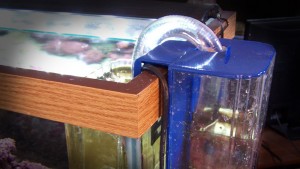Marine aquarium hobbyists whose tanks didn’t come with a built-in overflow or can’t be drilled to accommodate one (i.e., those made of tempered glass) sometimes choose to use a siphon-based hang-on-back (HOB) overflow to feed water from the aquarium to a sump. These overflows come in different designs, but they’re all more or less a variation on the same theme.
In very simple terms, they consist of two chambers: a slotted box that is positioned inside the tank and skims water from the surface, and another box that hangs outside the tank. Water is drawn from the inside chamber to the external chamber via a siphon tube (or sometimes more than one tube). The water then flows under the influence of gravity out the bottom of the external chamber, through a hose, and down into the sump, where it’s pumped back to the main tank through a return hose.
While this type of overflow can be a viable alternative to built-ins, it does have some possible drawbacks, not the least of which is the potential for flooding your fishroom in the event of a power outage, pump failure, or loss of siphon. But if you do have an HOB overflow, there are some simple steps you can take to reduce this risk so you can rest easier whenever you’re out of the house, asleep, or otherwise unable to access the aquarium immediately. They include:
Choose the right sized sump and pump
In the event of a power or pump failure, water will continue to flow down to the sump until the level in the main tank drops below the slots in the internal chamber. If your sump can’t accommodate all the water to that point, it will overflow onto your floor. If you have any doubt, get yourself a bigger sump!
Of course, you’ll also need to make sure the return pump is properly rated for the overflow system you’ve purchased so it doesn’t pump water back to the display tank faster or slower than the overflow can deliver it to the sump. Your dealer can advise you which pump is appropriate for your overflow.
Drill the return
Another potential drawback to HOB overflows is that if power is lost or the return pump fails, the return hose (through which water is pumped from the sump back to the display tank) can act as a reverse siphon, pulling water from the display tank down to the sump until the mouth of the nozzle finally catches air and breaks the siphon. Again, depending on the size of your sump, how deep in the tank the nozzle extends, and the size of your aquarium, this may or may not result in flooding.
To eliminate this problem, all you have to do is drill a small hole in the nozzle just below or right at the water line so it draws very little water down to the sump before catching air. Nowadays, many of these systems come with these holes pre-drilled, so you don’t have to do it yourself. In any case, be sure to keep this hole clean of algae, calcium deposits, salt creep, etc. so it does the critical job it’s supposed to do in an emergency.
Guard against loss of siphon
Flooding can also result if the siphon that transports water from the internal overflow box to the external one gets disrupted. If this occurs, water will cease flowing down to the sump but the return pump will keep right on pumping, potentially overflowing the display tank and exposing the return pump to air. To prevent this:
- Make sure the internal and external overflow boxes (especially the slots in the internal one), siphon tube, return pump and hose, etc. are kept clean and well maintained. This will ensure vigorous water flow through the overflow system, thus preventing air bubbles from getting trapped in the siphon.
- Verify that in the case of a power outage, both openings of the siphon tube remain submerged in water after the flow has stopped completely. This will ensure that the siphon doesn’t break and flow will resume automatically when power is restored. Most HOB overflows these days are designed such, but it’s important to confirm this nonetheless.
- Watch for bubble buildup! The siphon tubes in HOB overflows have the tendency to accumulate air bubbles at their highest point. A few little bubbles won’t make much difference, but over time, a few little bubbles can become one big bubble and, ultimately, an air pocket that breaks the siphon.
- If you see bubbles starting to build up, raising the tube and lowering it with a bit of force several times (without removing the open ends from the water, of course) will often clear them. But again, this shouldn’t be a significant problem if the flow rate through the tube is sufficiently robust.
Also note that some HOB overflow systems are designed to be used with a lift pump that prevents air bubbles from accumulating in the siphon tube and quickly restores flow when power resumes after an outage.
Another step worth considering is using a float switch in conjunction with your return pump. Setting the float switch so the pump will shut off automatically if the water level in the sump dips too low will not only prevent your display tank from overflowing in the event of siphon loss, but it will also protect your costly return pump from running dry and burning out.



